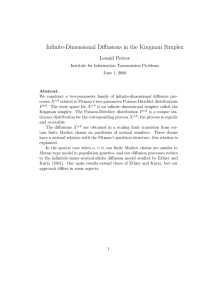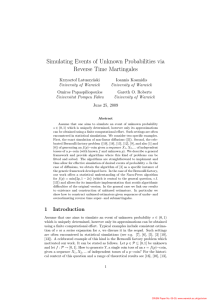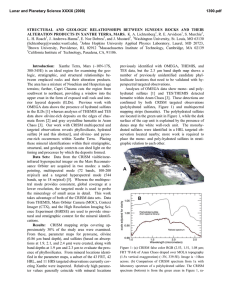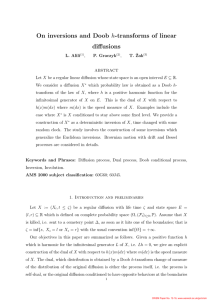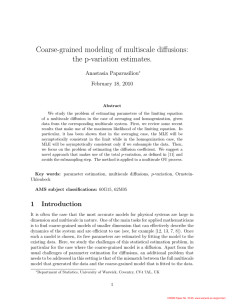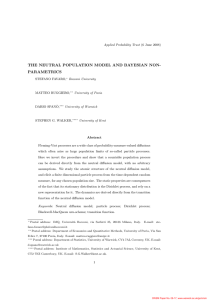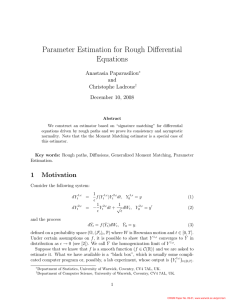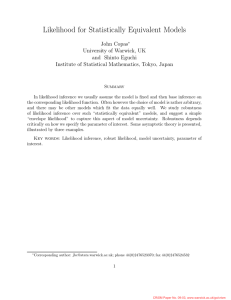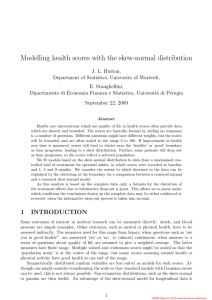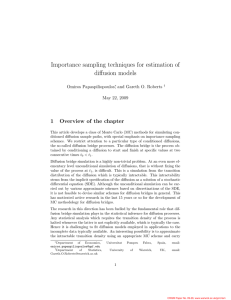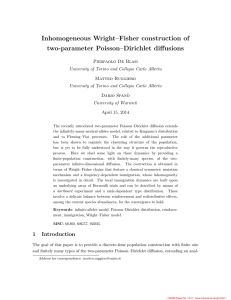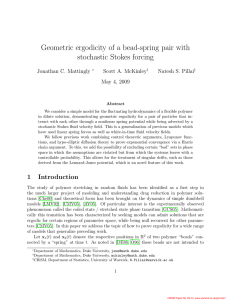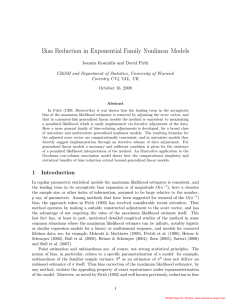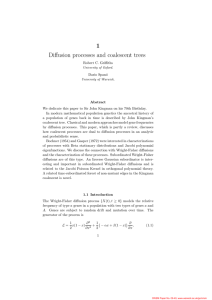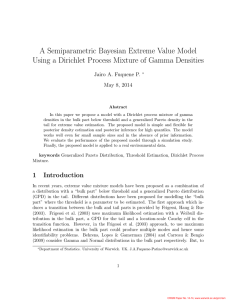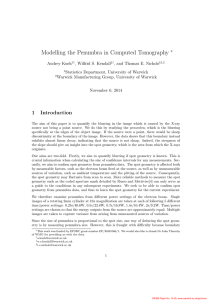Parametric estimation of discretely observed diffusions using the EM algorithm
advertisement
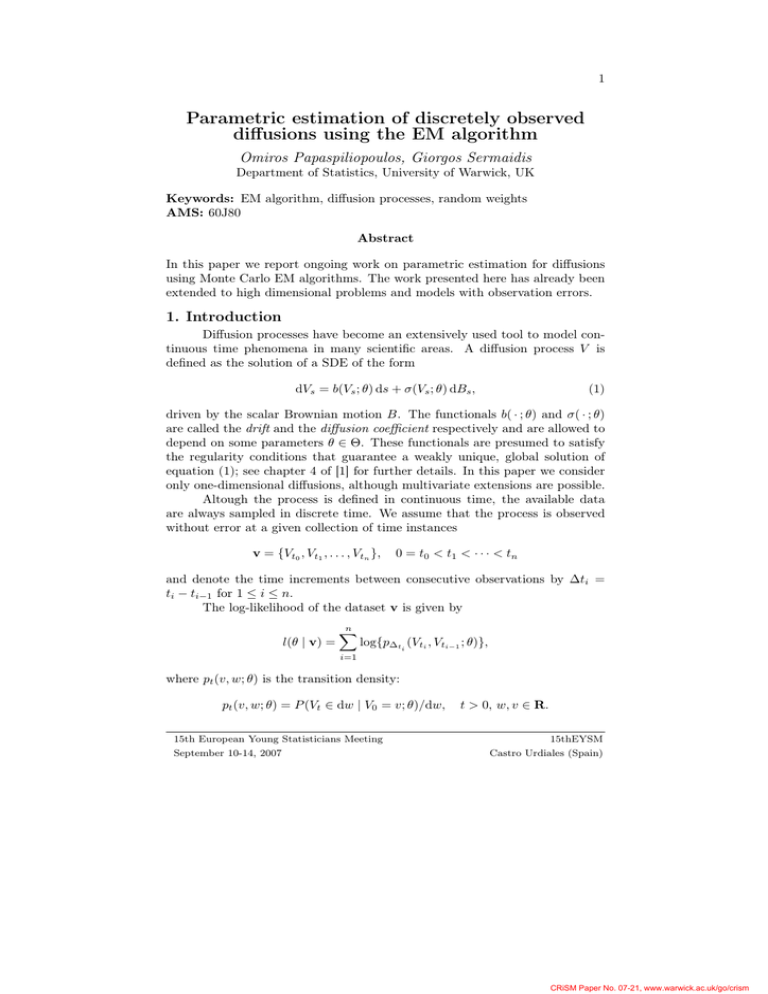
1
Parametric estimation of discretely observed
diffusions using the EM algorithm
Omiros Papaspiliopoulos, Giorgos Sermaidis
Department of Statistics, University of Warwick, UK
Keywords: EM algorithm, diffusion processes, random weights
AMS: 60J80
Abstract
In this paper we report ongoing work on parametric estimation for diffusions
using Monte Carlo EM algorithms. The work presented here has already been
extended to high dimensional problems and models with observation errors.
1. Introduction
Diffusion processes have become an extensively used tool to model continuous time phenomena in many scientific areas. A diffusion process V is
defined as the solution of a SDE of the form
dVs = b(Vs ; θ) ds + σ(Vs ; θ) dBs ,
(1)
driven by the scalar Brownian motion B. The functionals b( · ; θ) and σ( · ; θ)
are called the drift and the diffusion coefficient respectively and are allowed to
depend on some parameters θ ∈ Θ. These functionals are presumed to satisfy
the regularity conditions that guarantee a weakly unique, global solution of
equation (1); see chapter 4 of [1] for further details. In this paper we consider
only one-dimensional diffusions, although multivariate extensions are possible.
Altough the process is defined in continuous time, the available data
are always sampled in discrete time. We assume that the process is observed
without error at a given collection of time instances
v = {Vt0 , Vt1 , . . . , Vtn },
0 = t0 < t1 < · · · < tn
and denote the time increments between consecutive observations by ∆ti =
ti − ti−1 for 1 ≤ i ≤ n.
The log-likelihood of the dataset v is given by
l(θ | v) =
n
X
log{p∆ti (Vti , Vti−1 ; θ)},
i=1
where pt (v, w; θ) is the transition density:
pt (v, w; θ) = P (Vt ∈ dw | V0 = v; θ)/dw,
15th European Young Statisticians Meeting
September 10-14, 2007
t > 0, w, v ∈ R.
15thEYSM
Castro Urdiales (Spain)
CRiSM Paper No. 07-21, www.warwick.ac.uk/go/crism
EM for diffusions
2
Estimation of the parameters of the diffusion process via maximum likelihood
(ML) is hard since the transition density is typically not analytically available.
On the other hand, ML estimation for continuous observed v is straightforward since a likelihood can be easily derived (see (3)). This suggests treating
the paths between consecutive observations as missing data and proceed to
parameter estimation using the Expectation-Maximization algorithm.
2. An Expectation-Maximization approach
The EM algorithm is a general purpose algorithm for maximum likelihood estimation in a wide variety of situations where the likelihood of the observed data is intractable but the joint likelihood of the observed and missing
data has a simple form (see [2]). The algorithm works for any augmentation
scheme however appropriately defined missing data can lead to easier and more
efficient implementation. Without loss of generality we assume two data points
and denote the observed data by vobs = {V0 = u, Vt = w}.
The aim is to appropriately transform the missing paths so that the
complete likelihood can be written in an explicit way. This is achieved by
applying two transformations. First, we transform Vs → η(Vs ) =: Xs , where
Zu
η(u; θ) =
1
dz .
σ(z; θ)
Applying Itô’s rule to the transformed process we get that
dXs = α(Xs ; θ) ds + dBs ,
where
α(u; θ) =
X0 = x, s ∈ [0, t],
0
b{η −1 (u; θ); θ}
− σ {η −1 (u; θ); θ} / 2,
σ{η −1 (u; θ); θ}
(2)
u ∈ R;
0
η −1 denotes the inverse transformation and σ denotes the derivative w.r.t. the
space variable. Note that the starting and ending point are functions of θ as
x = η(u; θ) and y = η(w; θ). Let
Z u
α(z; θ)dz
A(u; θ) :=
be any anti-derivative of α and p̃t (x, y; θ) be the transition density of X. Second, we apply the transformation Xs → Ẋs where:
s
s
Ẋs := Xs − (1 − ) x(θ) − y(θ), s ∈ [0, t].
t
t
Ẋ is a diffusion bridge starting from Ẋ0 = 0 and finishing at Ẋt = 0 and its
dynamics depend on θ. The inverse transformation from Ẋ to X is:
s
s
gθ (Ẋs ) := Ẋs + (1 − ) x(θ) + y(θ), s ∈ [0, t].
t
t
15th European Young Statisticians Meeting
September 10-14, 2007
15thEYSM
Castro Urdiales (Spain)
CRiSM Paper No. 07-21, www.warwick.ac.uk/go/crism
EM for diffusions
3
The augmentation scheme for the EM algorithm is vmis = (Ẋs , s ∈ [0, t]) for
the missing data and vcom = {vobs , vmis } for the complete data.
(t,x,y)
Let W(t,x,y) be the standard Brownian Bridge (BB) measure and Qθ
the corresponding measure induced by the diffusion process (2). The conditional density of Ẋ on the observed data (w.r.t. the standard BB measure) is
derived using Lemma 2 in [3] as:
(t,x,y) n
o
n
o
dQθ
g
(
Ẋ
)
=
G
g
(
Ẋ
)
θ
s
θ
θ
s
dW(t,x,y)
½
¾
Z t
0
Nt (y − x)
1 2
Gθ (ω) =
exp A(y; θ) − A(x; θ) −
(α + α )(ωs ; θ)ds , (3)
p̃t (x, y; θ)
0 2
π(Ẋ | vobs , θ) =
where ω is any path starting at x at time 0 and finishing at y at time t and
Nt (u) is the density of the normal distribution with mean 0 and variance t
evaluated at u ∈ R. The complete log-likelihood can now be written as
l(θ | vcom ) =
log |η 0 (w; θ)| + log[Nt {y(θ) − x(θ)}] + A{y(θ); θ} − A{x(θ); θ}
Z t
1 2
(α + α0 ){gθ (Ẋs ); θ} ds.
−
0 2
It is helpful to introduce the random variable U ∼ Un[0, t], which is independent
of vcom . The E-step requires analytic evaluation of
Q(θ, θ0 ) = Evmis |vobs ;θ0 [ l(θ | vcom ) ] = log |η 0 (w; θ)| + log Nt {y(θ) − x(θ)}
0
t
+A{y(θ); θ} − A{x(θ); θ} − E(vmis ,U )|vobs ;θ0 [ (α2 + α )(gθ (ẊU ); θ) ]. (4)
2
The expression above cannot be evaluated analytically so we will estimate it
by Monte Carlo. This suggests maximizing the estimator Q̃(θ, θ0 ) of Q(θ, θ0 )
which leads to a Monte Carlo Expectation Maximization algorithm (MCEM).
2.1. Exact Simulation
One solution to the problem would be given by simulating M samples
from ẊU and estimating the intractable expectation with its sample average.
Recent advances in simulation methodology have made exact simulation (ES)
of diffusion processes feasible. The technique is called Retrospective Sampling
and the resulting algorithm Exact Algorithm (EA). The simulation is based on
rejection sampling; details are not presented in this paper but the reader can
see [3] for further details. So the θ(s+1) estimate of the MCEM algorithm is
found as follows:
1. Simulate ui ∼ Un[0, t], for i = 1, 2, . . . , M .
(t,x,y)
2. Simulate xui ∼ Qθ(s)
using the EA.
3. Apply the transformation in (2).
15th European Young Statisticians Meeting
September 10-14, 2007
15thEYSM
Castro Urdiales (Spain)
CRiSM Paper No. 07-21, www.warwick.ac.uk/go/crism
EM for diffusions
4
Get θ(s+1) by maximizing
4.
Q̃(θ, θ(s) ) =
log |η 0 (w; θ)| + log Nt {y(θ) − x(θ)} + A{y(θ); θ}
−A{x(θ); θ} −
M
t X 2
(α + α0 ){gθ (ẋui ); θ}.
2M i=1
2.2.
Importance Sampling
A drawback of estimating Q(θ, θ0 ) with the EA is that the latter is based
on rejection sampling which implies the simulation of a larger number of samples than M that we actually use. This observation suggests to proceed to an
Importance Sampling (IS) estimation for the unknown expectation in (4). The
idea is to simulate M samples from a standard Brownian Bridge and weight
them by the likelihood ratio (3). This expression cannot be calculated analytically. However, following the approach by [4] we only need unbiased estimates
of the weights which can be derived using the Poisson Estimator (see [3]). Let
f (Ẋs ; θ) =
0
1 2
(α + α ){gθ (Ẋs ); θ}.
2
Let c ∈ R, λ > 0 be user-specified constans, and Ψ = {ψ1 , ...ψκ } be a Poisson
process of rate λ on [0, t]. Then it can be checked that
½ Z t
¾
κ
³
´
Y
c − f (Ẋψj ; θ)
exp −
f (Ẋs )ds = exp{(λ − c)t}E wθ | Ẋ , wθ =
.
λ
0
j=1
So,
1.
2.
3.
4.
5.
the θ(s+1) estimate of the MCEM algorithm using IS is derived by:
Simulate κi ∼ P o(λt), for i = 1, 2, . . . , M .
(i)
Simulate ψj ∼ Un[0, t], for j = 1, 2, . . . , κi + 1.
Simulate ẋψ(i) ∼ W(t,0,0) .
j
(i)
For every i use first κi samples to estimate the weight wθ(s) .
Get θ(s+1) by maximizing
Q̃(θ, θ(s) ) = log |η 0 (w; θ)| + log Nt {y(θ) − x(θ)} + A{y(θ); θ}
½ µ
¶ ¾
M
P
(i)
t (α2 + α0 ) gθ ẋψ(i)
; θ wθ(s)
κi +1
i=1
−A{x(θ); θ} −
.
M
P
(i)
2
wθ(s)
i=1
15th European Young Statisticians Meeting
September 10-14, 2007
15thEYSM
Castro Urdiales (Spain)
CRiSM Paper No. 07-21, www.warwick.ac.uk/go/crism
EM for diffusions
5
3. An illustrative example
−731.5
Log−likelihood
−732.5
−800
−732.0
−780
Log−likelihood
−760
−731.0
−730.5
−740
The algorithms are applied to an Ornstein-Uhlenbeck (OU) process for
which b(v; θ) = −θv, σ(v; θ) = 1.0, θ ∈ (0, +∞). This process has been chosen
for illustration since the likelihood is available in this case. A sample size of
1000 observations was simulated from the process using θ = 2.0 and V0 = 0.0.
The algorithms were performed using M = 100 for the first five iterations and
M = 1000 for the last five. The initial value was θ(0) = 1.0, the MLE was
2.00274 and θ(10) was 2.00107 and 1.99918 for the ES and IS implementations
respectively. The results are shown in Figure 1.
2
4
6
8
10
Iteration
3
4
5
6
7
8
9
10
Iteration
Figure 1: The log-likelihood evaluated at every EM iteration. The dotted line
represents the ES method, the solid line the IS method and the dashed line the
log-likelihood evaluated at the true MLE. The right panel zooms at the last
seven iterations.
4. Bibliography
[1] Kloeden, P. and Platen, E. (1995) Numerical Solution of Stochastic Differential Equations. New York: Springer.
[2] Dempster, A. P., Laird, N. M. and Rubin, D. B. (1997) Maximum likelihood
from incomplete data via the em algorithm (with discussion). J. R. Statist.
Soc. B, 39, 1–38.
[3] Beskos, A., Papaspiliopoulos, O., Roberts, G. O. and Fearnhead, P. (2006)
Exact and computationally efficient likelihood-based estimation for discretely observed diffusion processes. J. R. Stat. Soc. Ser. B Stat. Methodol.,
68, 333–382.
[4] Fearnhead, P., Papaspiliopoulos, O. and Roberts, G. O. (2006) Particle
filters for partially observed diffusions. In revision.
15th European Young Statisticians Meeting
September 10-14, 2007
15thEYSM
Castro Urdiales (Spain)
CRiSM Paper No. 07-21, www.warwick.ac.uk/go/crism

